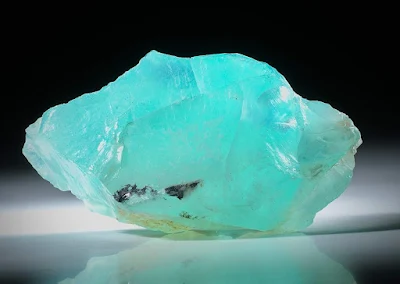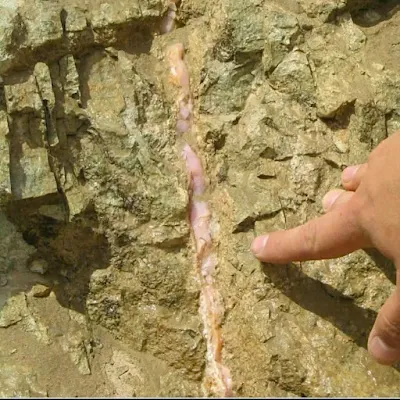Peruvian Opal: Colors and Meaning
Peruvian opal is a type of opal that is found in Peru, South America. It is known for its distinctive pastel colors, including shades of blue, green, pink, and purple. Unlike traditional opals, Peruvian opals often lack the characteristic play-of-color, which is the flashing or changing of colors as the gemstone is moved.
Peruvian opals are typically opaque to translucent, and they can exhibit a range of patterns, including mottled, dendritic (tree-like inclusions), and sometimes even a cat's eye effect. These gemstones are often cut into cabochons to showcase their unique colors and patterns.
Peruvian opal is the national stone of Peru, highlighting its cultural importance and association with the country's identity.
 |
| Peruvian Opal Colors |
Colors and Types of Peruvian Opal
There are several varieties of Peruvian opal, each with its own unique characteristics:
Blue Peruvian Opal: This is the most common type and is characterized by its pale blue to blue-green colors. The blue color in Peruvian opals is often attributed to the presence of copper within the opal. Copper ions absorb certain wavelengths of light, resulting in the characteristic blue hues.
Pink Peruvian Opal: This variety ranges from light pink to deeper rose hues. Their pink hue comes from quinone molecules, organic compounds often found in plants. These quinones get trapped within the opal during its formation, absorbing specific wavelengths of light and giving off the pink color we see.
Green Peruvian Opal: Although less common than blue and pink, green Peruvian opal can be found. is often caused by chromium or nickel inclusions. The varying shades of green are a result of different concentrations of copper ions.
Purple Peruvian Opal: This type exhibits purple to violet hues, The purple tones in Peruvian opals may be influenced by the presence of manganese or other trace elements. These elements contribute to the purple hues seen in some opals.
Yellow Peruvian Opal: Yellow Peruvian opal is less common, but it can be found. The yellow color in Peruvian opals can be influenced by the presence of iron. Iron ions can absorb specific wavelengths of light, giving rise to the yellow hues.
Dendritic Opal: This type, found in both blue and pink varieties, features black fern-like inclusions caused by manganese oxide.
Andean Opal: This refers to the specific type of opal found in the Andean mountains, primarily in Peru. It is characterized by its vibrant colors, including blue, green, and pink, and its smooth, matte finish.
 |
| Andean Opal from Acari Mine, Acarí District, Caravelí Province, Arequipa, Peru |
What is the value of Peruvian opal?
The value of Peruvian opal depends heavily on several factors, making it difficult to give a blanket answer. Here's a breakdown of key aspects:
Variety and Color:
Blue opal: Most common and affordable, ranging from $10-100/carat for lower grades, with higher quality specimens reaching $200-500/carat.
Pink opal: Rarer, commanding a premium. Expect $50-200/carat for lower grades, with exceptional pieces reaching $500+ per carat.
Green, yellow, and white: Extremely rare, value varies greatly depending on quality and intensity, potentially reaching thousands per carat.
Intensity and saturation: Deeper, more vibrant colors are generally more valuable.
Pattern and inclusions: Dendritic patterns can add interest, while flaws or fractures can reduce value.
Transparency: Translucent or semi-translucent opals are more desirable than opaque ones.
Size and weight: Larger, heavier stones typically fetch more, but quality matters more than size alone.
Cut and polish: A well-cut and polished stone showcases its beauty best, enhancing its value. Rough (uncut) opal is typically cheaper, while finished jewelry pieces can be significantly more expensive.
 |
| Rough Peruvian dendritic opal. Photo: Adam Kelly |
Uses and Applications
Peruvian opal has a variety of uses, ranging from decorative and artistic to potential therapeutic applications. Here's a breakdown of its main uses:
Jewelry: The most common use, Peruvian opal is set in rings, necklaces, pendants, earrings, and more. Its diverse colors and patterns make it popular for creating unique and eye-catching pieces.
Carvings and Sculptures: Due to its relative softness compared to other gemstones, Peruvian opal is sometimes used for carving intricate designs and sculptures. Artisans create decorative items, figurines, and ornaments using this beautiful gemstone.
Beads and Cabochons: Peruvian opal is often shaped into beads and cabochons for use in beadwork and cabochon settings in jewelry making. Its soothing colors make it a popular choice for creating elegant and eye-catching pieces.
Intarsia and mosaics: Opal pieces can be used to create intricate patterns and designs in furniture, decorative objects, and artwork.
Fashion: Opal cabochons are sometimes incorporated into clothing and accessories, adding a touch of elegance and natural beauty.
 |
| Pink Peruvian Opal |
Peruvian Opal Meaning
Peruvian opal carries a rich symbolism and diverse meanings, both cultural and metaphysical. Here's a breakdown:
Cultural Significance:
National Stone of Peru: Held dear by the Peruvian people, it embodies the beauty and spirit of the Andes mountains.
Inca Heritage: Believed to be gifts from Pachamama, the Earth Mother goddess, holding protective and healing powers.
Symbol of Hope and Harmony: Used in ancient art and rituals to promote peace and well-being.
Metaphysical and Gemstone Meanings:
Emotional Healing:
Pink opal, in general, is believed to have a soothing and calming energy. It is often associated with emotional healing, helping to release past traumas, and promoting feelings of love, compassion, and peace. It is thought to assist in emotional balance and stability.
Heart Chakra Activation:
Many practitioners of crystal healing and metaphysics associate pink opal with the heart chakra. The heart chakra is believed to govern emotions, love, and compassion. Pink opal is thought to open and activate the heart chakra, facilitating the flow of love and positive energy.
Spiritual Growth:
Peruvian opal, like other opals, is sometimes seen as a stone that aids in spiritual growth. It may be used for meditation and connecting with higher spiritual realms. Some believe that it enhances spiritual insight and intuition.
Harmony and Balance:
Pink opal is often associated with bringing harmony and balance into one's life. It is said to help harmonize the emotional, mental, and spiritual aspects of an individual, fostering a sense of equilibrium.
Communication and Relationships:
Pink opal is sometimes associated with improving communication and enhancing relationships. It is believed to promote understanding, empathy, and effective communication in both personal and professional relationships.
It's essential to approach these meanings with an open mind and understand that they are part of the spiritual and metaphysical aspects associated with crystals and gemstones.
 |
| Peruvian Opal. Photo: Atelier Hochstrasser |
FAQ
How to care for Peruvian opal
Avoid harsh chemicals: Clean with mild soap and water, and avoid household cleaners like ammonia or bleach.
Protect from scratches: Opal is a relatively soft gemstone, so avoid wearing it during activities that could scratch it.
Store carefully: Wrap opal jewelry in a soft cloth and store it in a cool, dry place away from direct sunlight.
Is Peruvian opal rare?
Peruvian opal is not as rare as some other gemstones, but it's not as common as others either. Compared to the most common type of opal, Ethiopian opal, Peruvian opal is less abundant and geographically limited to the Andes mountains.
Not as rare as play-of-color opals: Peruvian opal lacks the internal structure that creates the "fire" effect found in Australian and Ethiopian play-of-color opals, which are generally considered rarer and more valuable.
 |
| Pink opal veins in the mountains, Peru. |
Conclusion:
Peruvian opal, with its alluring colors and inherent elegance, continues to captivate gemstone enthusiasts and artisans alike. Whether adorning a piece of jewelry, gracing a decorative sculpture, or serving as a meaningful souvenir, Peruvian opal stands as a testament to the rich geological wonders of Peru and the enduring appeal of nature's artistic creations.
Read also:
Opal Patterns with Photos
Opal Pineapples
Chocolate Opal








